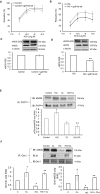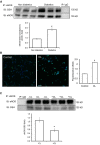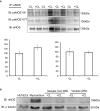β3 Adrenergic Stimulation Restores Nitric Oxide/Redox Balance and Enhances Endothelial Function in Hyperglycemia
- PMID: 26896479
- PMCID: PMC4802476
- DOI: 10.1161/JAHA.115.002824
β3 Adrenergic Stimulation Restores Nitric Oxide/Redox Balance and Enhances Endothelial Function in Hyperglycemia
Abstract
Background: Perturbed balance between NO and O2 (•-). (ie, NO/redox imbalance) is central in the pathobiology of diabetes-induced vascular dysfunction. We examined whether stimulation of β3 adrenergic receptors (β3 ARs), coupled to endothelial nitric oxide synthase (eNOS) activation, would re-establish NO/redox balance, relieve oxidative inhibition of the membrane proteins eNOS and Na(+)-K(+) (NK) pump, and improve vascular function in a new animal model of hyperglycemia.
Methods and results: We established hyperglycemia in male White New Zealand rabbits by infusion of S961, a competitive high-affinity peptide inhibitor of the insulin receptor. Hyperglycemia impaired endothelium-dependent vasorelaxation by "uncoupling" of eNOS via glutathionylation (eNOS-GSS) that was dependent on NADPH oxidase activity. Accordingly, NO levels were lower while O2 (•-) levels were higher in hyperglycemic rabbits. Infusion of the β3 AR agonist CL316243 (CL) decreased eNOS-GSS, reduced O2 (•-), restored NO levels, and improved endothelium-dependent relaxation. CL decreased hyperglycemia-induced NADPH oxidase activation as suggested by co-immunoprecipitation experiments, and it increased eNOS co-immunoprecipitation with glutaredoxin-1, which may reflect promotion of eNOS de-glutathionylation by CL. Moreover, CL reversed hyperglycemia-induced glutathionylation of the β1 NK pump subunit that causes NK pump inhibition, and improved K(+)-induced vasorelaxation that reflects enhancement in NK pump activity. Lastly, eNOS-GSS was higher in vessels of diabetic patients and was reduced by CL, suggesting potential significance of the experimental findings in human diabetes.
Conclusions: β3 AR activation restored NO/redox balance and improved endothelial function in hyperglycemia. β3 AR agonists may confer protection against diabetes-induced vascular dysfunction.
Keywords: endothelial dysfunction; endothelial nitric oxide synthase; hyperglycemia; oxidative stress; β3 adrenergic receptors.
© 2016 The Authors. Published on behalf of the American Heart Association, Inc., by Wiley Blackwell.
Figures








References
-
- Guzik TJ, Harrison DG. Vascular NADPH oxidases as drug targets for novel antioxidant strategies. Drug Discovery Today. 2006;11:524–533. - PubMed
-
- Zimmet JM, Hare JM. Nitroso‐redox interactions in the cardiovascular system. Circulation. 2006;114:1531–1544. - PubMed
-
- Burgoyne JR, Mongue‐Din H, Eaton P, Shah AM. Redox signaling in cardiac physiology and pathology. Circ Res. 2012;111:1091–1106. - PubMed
Publication types
MeSH terms
Substances
LinkOut - more resources
Full Text Sources
Other Literature Sources
Medical
Molecular Biology Databases
Research Materials
Miscellaneous

